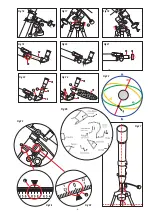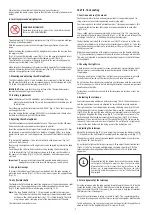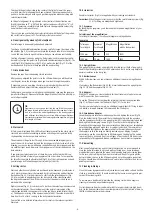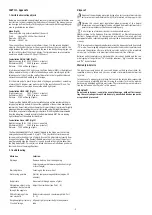
- 7 -
Place the tube in the middle of the holder and close the clamps.
Hand-tighten the clamp screws again so that the tube is securely fastened in the
holder.
6. Insert eyepiece and upright prism
DANGER OF BLINDNESS!
Never look directly at, or near to the sun with this device.
There is a RISK OF BLINDNESS!
Two eyepieces (Fig 2, 18) and an upright prism (Fig 2, 19) are supplied with your
telescope as basic equipment.
With the eyepieces you determine the respective magnification of your tele-
scope.
Before inserting the eyepieces and the upright prism, remove the dust cap from
the eyepiece tube.
(Fig 1, 6) Loosen the clamping screw (Fig 12, X) on the eyepiece tube and insert
the upright prism first. Then retighten the clamping screw (Fig 12, X).
Then fix the 20mm eyepiece in the upright prism in the same way by opening
and closing the clamping screw (Fig 13a, X).
Make sure that the eyepiece sight points vertically upwards. This facilitates easy
viewing. Otherwise, loosen the clamping screw (Fig 12, X) on the eyepiece tube
and turn the upright prism to this position.
7. Mounting and adjusting the LED viewfinder
The LED viewfinder (Fig 1a, 2) and its holder form a single unit. Slide the base of
the LED viewfinder fully in to the corresponding base on the telescope tube (Fig
10, X) and then tighten the clamping screw (Fig 10, Y).
IMPORTANT:
Make sure that the mirror surface of the LED viewfinder points
towards the tube opening when attaching it.
7.1. Battery replacement
Note:
The battery of the LED viewfinder is protected against discharge by a
plastic foil when delivered. This must be removed before switching on for
the first time!
Press sideways on the battery insert marked "PUSH" (Fig 1a, W) so that it pops out
on the opposite side.
Insert the battery (button cell type CR2032, 3V) into the holder and slide the hol-
der back into the housing of the LED viewfinder.
8. Adjusting the LED viewfinder
The LED viewfinder must be adjusted before use. This means that the LED view-
finder and the telescope tube must be aligned in parallel.
Insert the eyepiece with the largest focal length into the upright prism (13). Aim
the telescope at a prominent object at a distance of approx. 300 m (e.g. house
gable, church spire, etc.) until it appears in the centre of the field of view (Fig14,
A).
Turn on the LED viewfinder. To do this, turn the front knurled screw (Fig 1a, Z)
until a soft click is heard.
If necessary, the brightness of the light spot can be adjusted by turning the knob
further.
Look through the LED viewfinder and adjust it by turning the horizontal (Fig
1a, X) and vertical (Fig 1a, Y) adjustment screws so that you see the red dot in
the center of the image (Fig14, C). The LED viewfinder and telescope are now
matched.
Important:
The image in the telescope will be upside down unless you use
appropriate accessories to invert the image (e.g. zenith prism).
9. Use protective caps
To protect the inside of your telescope from dust and dirt, the tube opening is
protected by a dust cap (Fig 11, X). There is also a dust cap on the eyepiece tube
(Fig 1, 6).
10. Use flexible shafts
The flexible shafts facilitate the exact fine adjustment of the declination and right
ascension axis. They are pushed onto the holders provided for the two axles
(Fig13, Y) and fixed with the small clamping screws (Fig 13, X).
Note:
The long flexible shaft (Fig 1, 14) is mounted parallel to the telescopic
tube. The fastening is done with a clamping screw at the provided notch
of the axle. The short flexible shaft (Fig 1, 15) is fitted laterally. The faste-
ning is done with a clamping screw at the provided notch of the axle.
The telescope is now ready for use.
PART II - The handling
1. Function and use of the mount
The following information is extremely important for the positioning and tra-
cking accuracy of your telescope during an observing night.
Your telescope has a so-called "parallactic mount" (also equatorial mount). This
is characterized by two axes that can be rotated perpendicular to each other
(Fig15, a+b)
The so-called right ascension axis (also RA or hour axis) (Fig 15, b) must be alig-
ned parallel to the polar axis of the earth (Fig 25, c). For the correct setting of the
pole height, see Part II - 4. Handling - Adjusting the telescope).
The declination axis (also DEC or elevation axis) (Fig15, a) is used to set the alti-
tude of a celestial object in relation to the celestial equator (Fig 25, d). To do this,
take the declination coordinate of a celestial object from a star chart or discover
the objects yourself.
With the manual operation of the right ascension axis via the flexible shaft (Fig
1, 15) you continuously compensate the earth rotation in the opposite direction.
This way, your selected (= positioned) object always remains in the field of view
of the eyepiece.
2. Choosing the right site
A dark location is very important for many observations, since disturbing lights
(lamps, lanterns) can considerably impair the sharpness of detail of the tele-
scope image.
When you go outdoors at night from a bright room, your eyes have to get used
to the darkness. After about 20 minutes you can start astro-observation.
Do not observe from closed rooms and place your telescope with the accessories
in its location approx. 30 min. before starting observation to ensure temperature
equalization in the tube.
Furthermore, you should make sure that this telescope is placed on a level, sta-
ble surface.
3. Balancing the telescope
Your telescope must be balanced before observing. That is, the declination axis
and the right ascension axis are adjusted for smooth and accurate operation.
The right ascension axis is balanced by loosening the fixing screw (Fig15, I) and
tilting the weight rod to a horizontal position. Now move the counterweight
(Fig15, H) on the rod until the tube and the counterweight remain in this horizon-
tal position. Retighten the fixing screw (Fig15, I) of the right ascension axis. The
declination axis is balanced by loosening the fixing screw (Fig15, D) of the dec-
lination axis. Then loosen the screws of the tube holder (Fig15, A) and move the
tube until it also remains in a horizontal position. Do not forget to re-tighten the
screws of the tube holder and the fixing screw of the declination axis.
4. Adjusting the telescope
Adjust the latitude axis (Fig15, F) (pole height) by loosening the fixing screw (Fig
17, X) and adjust the Pohl height accordingly with the adjusting screw (Fig 17, Y).
The number on which you set the axis depends on the latitude of your location
(e.g. Munich 48°, Hamburg 53°).
Do not forget to tighten the fixing screw again. Then adjust the declination axis
(Fig15, C) to 90° by loosening and tightening the fixing screw (Fig15, D). The
telescope tube is now aligned parallel to the Earth's axis. This is called polar
alignment.
TIP:
You will always find the latitude of your exact observation location
on the right or left edge of a map in an atlas. You can also obtain
information from your local council, land registry office or on the
Internet: e.g. at www.heavens-above.com. There you can select
your country under "Anonymous user > Select"; the data will then
be displayed.
i
5. Polar alignment of the telescope
Point the telescope with the tube opening forward towards the north. To do this,
loosen the locking screw (Fig 18). Now you can rotate the telescope tube and
align it exactly to the north. If necessary, use a compass to help you. Afterwards,
the locking screw is fixed again.
Check that your telescope is set up as shown in Fig 27. The counterweight (Fig
27, X) points to the ground and thus forms a vertical axis together with the tube.
In this position you can see the polar region with the polar star through the vie-
wfinder. Polaris is the brightest object in this region. (Fig 26)



















